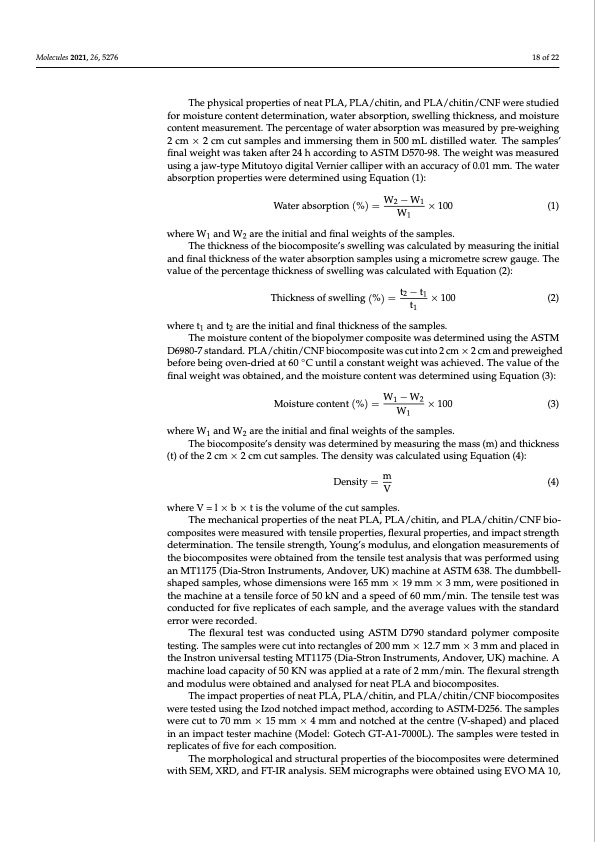
PDF Publication Title:
Text from PDF Page: 018
Molecules 2021, 26, 5276 18 of 22 The physical properties of neat PLA, PLA/chitin, and PLA/chitin/CNF were studied for moisture content determination, water absorption, swelling thickness, and moisture content measurement. The percentage of water absorption was measured by pre-weighing 2 cm × 2 cm cut samples and immersing them in 500 mL distilled water. The samples’ final weight was taken after 24 h according to ASTM D570-98. The weight was measured using a jaw-type Mitutoyo digital Vernier calliper with an accuracy of 0.01 mm. The water absorption properties were determined using Equation (1): Water absorption (%) = W2 − W1 × 100 (1) W1 where W1 and W2 are the initial and final weights of the samples. The thickness of the biocomposite’s swelling was calculated by measuring the initial and final thickness of the water absorption samples using a micrometre screw gauge. The value of the percentage thickness of swelling was calculated with Equation (2): Thickness of swelling (%) = t2 − t1 × 100 (2) t1 where t1 and t2 are the initial and final thickness of the samples. The moisture content of the biopolymer composite was determined using the ASTM D6980-7 standard. PLA/chitin/CNF biocomposite was cut into 2 cm × 2 cm and preweighed before being oven-dried at 60 ◦C until a constant weight was achieved. The value of the final weight was obtained, and the moisture content was determined using Equation (3): Moisture content (%) = W1 − W2 × 100 (3) W1 where W1 and W2 are the initial and final weights of the samples. The biocomposite’s density was determined by measuring the mass (m) and thickness (t) of the 2 cm × 2 cm cut samples. The density was calculated using Equation (4): Density = mV (4) where V = l × b × t is the volume of the cut samples. The mechanical properties of the neat PLA, PLA/chitin, and PLA/chitin/CNF bio- composites were measured with tensile properties, flexural properties, and impact strength determination. The tensile strength, Young’s modulus, and elongation measurements of the biocomposites were obtained from the tensile test analysis that was performed using an MT1175 (Dia-Stron Instruments, Andover, UK) machine at ASTM 638. The dumbbell- shaped samples, whose dimensions were 165 mm × 19 mm × 3 mm, were positioned in the machine at a tensile force of 50 kN and a speed of 60 mm/min. The tensile test was conducted for five replicates of each sample, and the average values with the standard error were recorded. The flexural test was conducted using ASTM D790 standard polymer composite testing. The samples were cut into rectangles of 200 mm × 12.7 mm × 3 mm and placed in the Instron universal testing MT1175 (Dia-Stron Instruments, Andover, UK) machine. A machine load capacity of 50 KN was applied at a rate of 2 mm/min. The flexural strength and modulus were obtained and analysed for neat PLA and biocomposites. The impact properties of neat PLA, PLA/chitin, and PLA/chitin/CNF biocomposites were tested using the Izod notched impact method, according to ASTM-D256. The samples were cut to 70 mm × 15 mm × 4 mm and notched at the centre (V-shaped) and placed in an impact tester machine (Model: Gotech GT-A1-7000L). The samples were tested in replicates of five for each composition. The morphological and structural properties of the biocomposites were determined with SEM, XRD, and FT-IR analysis. SEM micrographs were obtained using EVO MA 10,PDF Image | Supercritical Carbon Dioxide Isolation of Cellulose Nanofibre

PDF Search Title:
Supercritical Carbon Dioxide Isolation of Cellulose NanofibreOriginal File Name Searched:
molecules-26-05276-v2.pdfDIY PDF Search: Google It | Yahoo | Bing
Sulfur Deposition on Carbon Nanofibers using Supercritical CO2 Sulfur Deposition on Carbon Nanofibers using Supercritical CO2. Gamma sulfur also known as mother of pearl sulfur and nacreous sulfur... More Info
CO2 Organic Rankine Cycle Experimenter Platform The supercritical CO2 phase change system is both a heat pump and organic rankine cycle which can be used for those purposes and as a supercritical extractor for advanced subcritical and supercritical extraction technology. Uses include producing nanoparticles, precious metal CO2 extraction, lithium battery recycling, and other applications... More Info
| CONTACT TEL: 608-238-6001 Email: greg@infinityturbine.com | RSS | AMP |